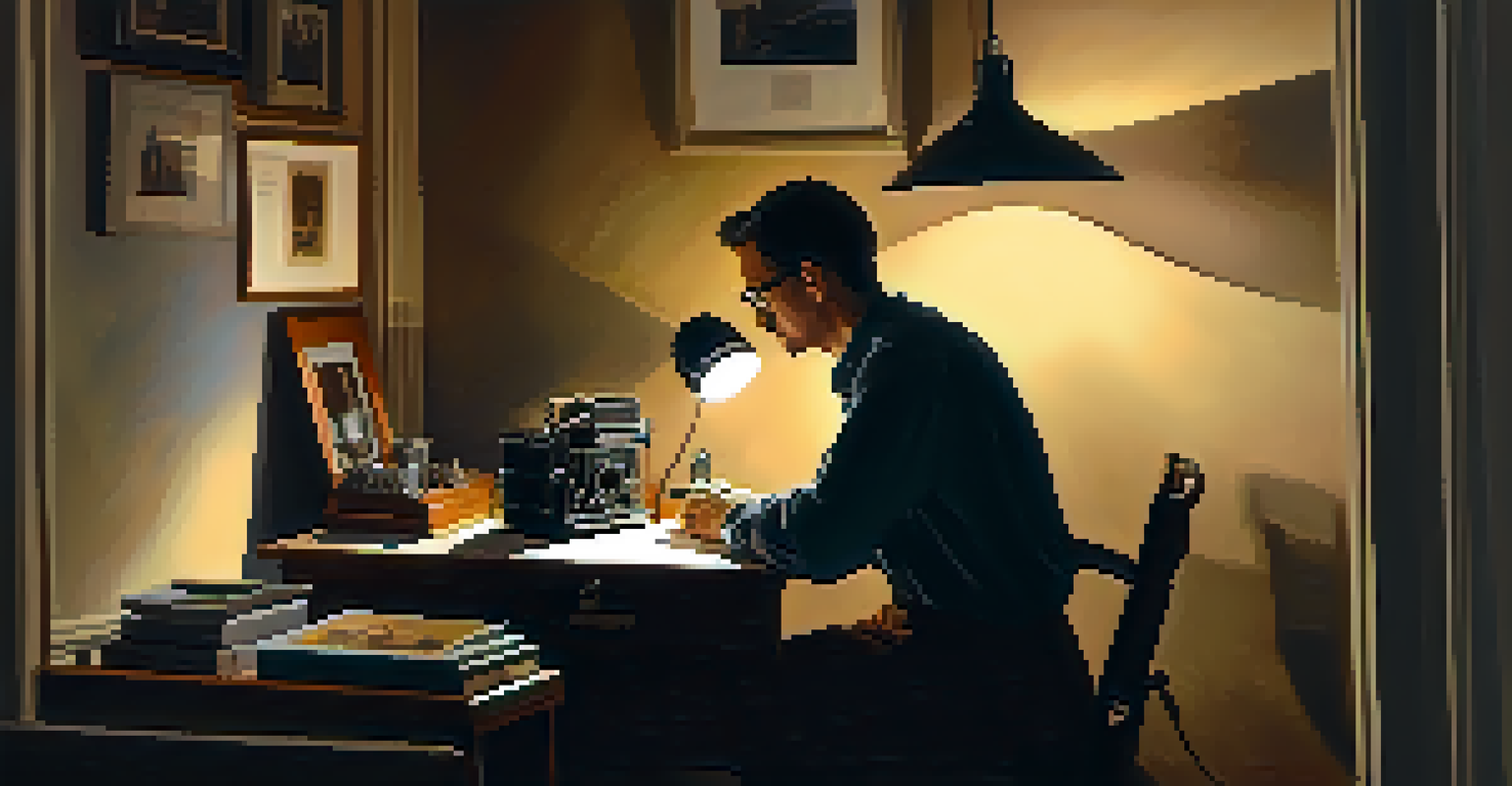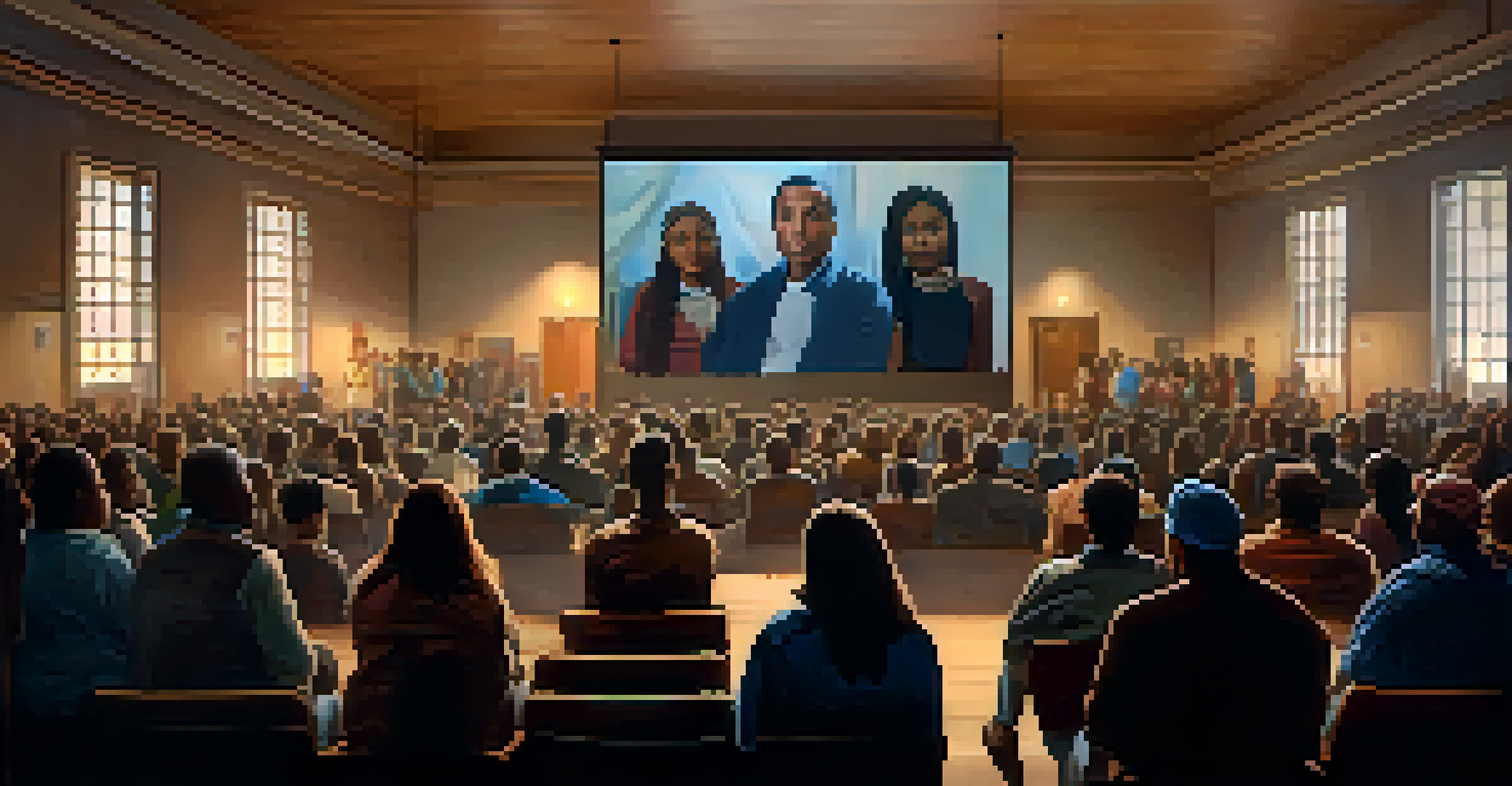Film as a Medium for Exploring Personal and Collective Memories

The Power of Film in Evoking Memories
Film has a unique ability to evoke memories, both personal and collective, by engaging viewers emotionally. When we watch a film, the combination of visuals, dialogue, and sound creates a rich tapestry that can trigger nostalgia. For example, a scene featuring a childhood home can instantly transport us back to our own past experiences, reminding us of our roots.
Film is a powerful means of communication, and it has the ability to preserve memories and tell stories that connect us to our past.
This emotional connection often makes films a powerful medium for storytelling, allowing filmmakers to explore themes of identity and memory. By crafting narratives that resonate with audiences, films can illuminate shared experiences and cultural histories. This is particularly relevant in documentaries, where real-life stories are showcased to highlight collective memories.
Moreover, the way films are structured—often with flashbacks or nonlinear storytelling—mirrors how our memories work. Just as we might recall a moment from our childhood while thinking about a present situation, filmmakers weave together timelines to create a richer narrative. This technique not only deepens our understanding of characters but also invites us to reflect on our own memories.
Personal Memories Captured on Screen
Personal memories in film often provide a window into the filmmaker's own experiences, allowing for intimate storytelling. Autobiographical films, for instance, serve as a canvas for directors to explore their pasts, revealing their thoughts and feelings. These films create a space for vulnerability, making it easy for audiences to connect on a personal level.

Consider films like 'The Diary of a Teenage Girl' or 'Boyhood', where the narratives are drawn from the filmmakers' lives. The authenticity in these stories resonates with viewers who may have faced similar experiences, fostering a sense of empathy and understanding. As we watch these stories unfold, we are reminded of our own journeys, sparking reflections on our memories.
Film Evokes Personal Memories
Films create emotional connections that trigger personal nostalgia and reflections on our own experiences.
Additionally, personal memory films often incorporate visual and auditory cues that enhance the storytelling experience. For example, the use of old photographs or familiar songs can evoke specific emotions tied to our own pasts. This connection between the film's content and our memories amplifies the impact of the narrative, making it a powerful tool for exploration.
Collective Memories and Cultural Narratives
Collective memories are memories shared by a group, community, or society, and films often serve as a medium to explore these narratives. Historical films, for instance, can shape our understanding of significant events by presenting them in a relatable way. Through the lens of cinema, viewers can engage with shared histories and cultural identities, reinforcing a sense of belonging.
Movies can and do have tremendous influence in shaping young lives in the realm of entertainment towards the ideals and objectives of normal adulthood.
Movies like 'Schindler's List' or '12 Years a Slave' illustrate the power of film in depicting traumatic collective memories. These films don't just recount historical events; they allow audiences to feel the weight of shared experiences. By doing so, they invite viewers to reflect on the impact of the past on present identities and societal structures.
Moreover, films can also highlight the resilience and strength of communities in the face of adversity. By showcasing stories of survival and triumph, they help foster a collective memory that celebrates shared struggles. This representation is crucial for cultural preservation, as it ensures that important narratives are not forgotten over time.
The Role of Nostalgia in Film
Nostalgia is a powerful emotion that can be intricately woven into the fabric of film. Many filmmakers deliberately use nostalgic elements to evoke a sense of longing for the past, often drawing from their own experiences. This can manifest in the aesthetic choices—like vintage cinematography or period-appropriate costumes—that transport audiences back in time.
Films such as 'The Notebook' or 'Stand by Me' tap into the universal experience of reminiscing about youth and simpler times. By crafting narratives that revolve around formative moments, these films resonate deeply with viewers, allowing them to reflect on their own lives. Nostalgia in film helps create a shared emotional experience that can bridge generational gaps.
Collective Memories in Cinema
Movies serve as a medium to explore shared cultural narratives, helping to shape our understanding of historical events and identities.
Furthermore, nostalgia can also serve as a critique of the present, encouraging audiences to consider how society has evolved. By contrasting the past with contemporary issues, filmmakers can provoke thought and discussion. This duality of nostalgia—celebrating cherished memories while questioning the current state of affairs—makes for a compelling cinematic experience.
Film Techniques That Highlight Memory
Filmmakers employ various techniques to effectively convey memories, enhancing the storytelling experience. For instance, the use of flashbacks allows viewers to see past events that shape a character's current reality. This technique creates a layered narrative that encourages deeper engagement with the characters and their histories.
Another common technique is the use of voice-over narration, where characters reflect on their past experiences while the visuals unfold. This method provides insight into the characters' thoughts, making their memories feel more tangible. Films like 'Eternal Sunshine of the Spotless Mind' utilize this technique to explore the complexities of memory and love, inviting viewers to ponder their own relationships.
Additionally, visual symbolism plays a crucial role in memory representation. Objects, colors, or even recurring motifs can signify important memories or experiences. For example, a specific song might evoke nostalgia for a past relationship, and filmmakers often use soundtracks to enhance these emotional connections, creating a richer narrative landscape.
The Impact of Film on Memory Construction
Films not only reflect memories; they can also shape how we construct and recall them. The portrayal of events and characters in cinema can influence our own perceptions and memories of similar experiences. This phenomenon is particularly evident in the way people remember historical events, often referencing films as a source of information.
For instance, films like 'Apollo 13' or 'The King's Speech' can create a sense of familiarity with historical figures and events, sometimes overshadowing actual historical accounts. As viewers, we may find ourselves connecting more with the dramatized versions of events than with the factual details. This highlights the responsibility filmmakers have in portraying history accurately while still crafting engaging narratives.
Nostalgia Shapes Film Experience
Filmmakers use nostalgic elements to connect audiences with their pasts, fostering reflection on both personal memories and societal evolution.
Moreover, the emotional resonance of films can lead to constructed memories, where viewers recall feelings associated with cinematic experiences. This emotional backdrop can affect how we remember our own lives, blending real memories with those formed through the lens of film. Ultimately, this intersection of film and memory invites us to examine the nature of our recollections and how they shape our identities.
Conclusion: Film as a Reflective Medium
In conclusion, film serves as a powerful medium for exploring both personal and collective memories. By weaving together narratives that resonate with viewers, filmmakers create an emotional landscape that encourages reflection and connection. This relationship between film and memory is not just a one-way street; it fosters dialogue about our pasts and how they shape our present.
As we engage with films that depict memories, we are reminded of the importance of storytelling in preserving cultural narratives. These stories allow us to honor our shared histories while also exploring our individual experiences. In this way, film becomes a tool for understanding and empathy, bridging gaps between different perspectives.

Ultimately, the exploration of memories through film enriches our understanding of ourselves and the world around us. It invites us to reflect on our identities, our connections to others, and the stories that bind us together. As we continue to embrace the art of storytelling, we find that film remains a vital medium for navigating the complexities of memory.